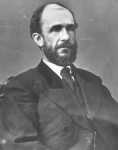Timber Claims and the Homestead Act

By SUSAN DOAK
SW Nebraska
Genealogy Society
McCOOK, Nebraska -- When researching one of our great-great grandfathers, Charles Ferdinand Smith, my cousin Sherri came across the notation on the Internet of a Timber Claim in his name. She was excited because it seemed it still existed these 100 years later ....but in whose name?
Tracing land is a lot easier than finding a trunk full of gold on the old homestead. After all, that is why all county seats have land records. I didn't even know what a timber claim was, but I was pretty sure I could track down who owned the land now and secondly, I was certain there wouldn't be many trees on that land because it was in Phillips County, Kansas!
What I found was a myriad of land records showing that Ferdinand (he dropped the Charles to delineate his name from another Charles Ferdinand Smith if you can believe it) had owned a Timber Claim which had been transferred back and forth between other relatives and himself about 8 times! That was an afternoon of digging through records for me until I found that the land had been sold to someone outside the family.
Mystery solved, or so I thought, until I found another great-great grandfather owned a Timber Claim in Cheyenne County Nebraska. Timber and Dalton, Nebraska? Now I had to know what a Timber Claim was!
The Timber Culture Act was passed as a follow-up to the Homestead Act and enacted by Congress in 1873. The Act allowed homesteaders to get another 160 acres of land if they planted trees on forty acres, later reduced to 10 acres.
Here are some of the requirements: Applications required a $ 10.00 fee which is equivalent to $ 196.00 in 2013. Immigrants could apply for this land, but they must be US Citizens prior to the 10 year proving up requirement. Trees could not be planted more than 12 feet apart. Unlike the Homestead Act, Timber Claims did not require residences on the land. At the end of 8 years, two credible witnesses had to attest to the fact that the trees were planted and cultivated properly and that no less than 675 trees survived out of the required 2700 trees planted per acre!
In Nebraska nearly 9 million acres were entered as tree claims, but only 2.5 million ever qualified as proved up. The Timber Culture Act was a good idea, successful in several states or territories but the weather of the Great Plains proved to be as difficult in 1873 as it is today.
The Timber Culture Act was authored by Phinneas W. Hitchcock, a Republican US Senator from Omaha and the person after which Hitchcock County was named. The act was repealed in 1891.
Facebook.com is another one of those web sites that make me question my sanity for signing up, but I am really getting a kick out of the page "Remember When in McCook Nebraska." That site has raised another genealogy question for a friend. A picture someone posted is of a saloon located directly across B Street from today's Hallmark store and she remembers being told a grandfather owned the establishment! More to come in future columns once the research is done!
